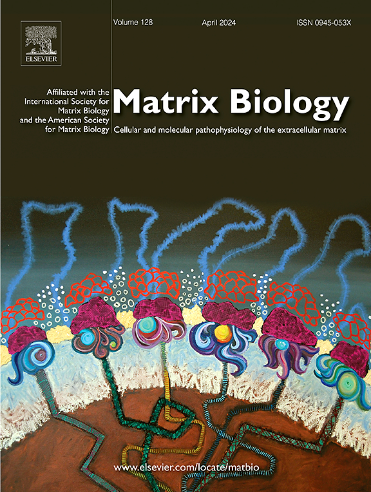跨膜和多蛋白胶原的发育和病理生物学。
IF 4.8
1区 生物学
Q1 BIOCHEMISTRY & MOLECULAR BIOLOGY
引用次数: 0
摘要
在最好的情况下,在解决精心形成的科学假设时,获得意想不到的发现是令人兴奋的。这篇综述描述了我在细胞外基质生物学领域的科学旅程,更具体地说,是在胶原蛋白研究方面,从1978年开始,一直到今天都有令人兴奋的发现。在叙述我早期在胶原蛋白生物合成酶方面的工作时,重点将放在我们发现的新型非纤维胶原蛋白上:属于胶原蛋白家族中MACIT亚群的XIII型胶原蛋白,以及构成多重蛋白亚群的XV和XVIII型胶原蛋白。我们通过分子生物学方法研究了这些胶原蛋白,以确定它们的初级结构,并通过生物化学和细胞生物学工作来了解它们的特殊分子特性。此外,许多小鼠模型的产生使我们对这些胶原蛋白在脂肪组织、骨骼、眼睛、心脏、肾脏、肝脏、周围神经、皮肤和癌症模型中的作用进行了令人兴奋的研究,尽管在为每个组织选择正确的方法方面当然也相当令人生畏。然而,在动物模型上的工作使人们对这些胶原蛋白在体内的意义有了广泛的了解,为研究它们与人类疾病(包括恶性过程)的相关性奠定了富有成果的基础。我们的结论是,这些胶原可以促进细胞外基质和组织结构的稳定性,例如,在多重蛋白的情况下,基底膜和邻近的纤维基质,在MACIT XIII型胶原的情况下,运动突触,更意想不到的是,它们作为细胞命运和功能的外在调节剂具有重要作用。本文章由计算机程序翻译,如有差异,请以英文原文为准。
Transmembrane and multiplexin collagens in development and pathobiology
At its best, it is exhilarating to make unexpected discoveries when addressing carefully formed scientific hypotheses. This review depicts my scientific journey in the field of extracellular matrix biology, and more specifically in collagen research, starting in 1978 and continuing with exciting findings up to the present day. While recounting my early work on the enzymes of collagen biosynthesis, the focus will be on our discoveries of new types of nonfibrillar collagen: type XIII collagen, belonging to the MACIT subgroup among the collagen family of proteins, and types XV and XVIII collagens, constituting the multiplexin subgroup. We have investigated these collagens through molecular biological approaches in order to define their primary structures, and through biochemical and cell biological work to understand their special molecular properties. Furthermore, the generation of many mouse models has led us to exciting studies of the roles of these collagens in adipose tissue, bone, eye, heart, kidney, liver, peripheral nerves, skin, and cancer models, although it has of course also been rather daunting in terms of choosing the correct approach for each tissue. The work on animal models has nevertheless resulted in a broad understanding of the in vivo significance of these collagens, forming a fruitful basis for studying their relevance to human diseases, including malignant processes. Our conclusions have been that these collagens can contribute to the stability of the extracellular matrix and tissue structures, e.g., the basement membrane and the adjacent fibrillar matrix in the case of the multiplexins and the motor synapse in the case of the MACIT type XIII collagen, and more unexpectedly, that they possess major roles as extrinsic regulators of the fates and functions of cells.
求助全文
通过发布文献求助,成功后即可免费获取论文全文。
去求助
来源期刊

Matrix Biology
生物-生化与分子生物学
CiteScore
11.40
自引率
4.30%
发文量
77
审稿时长
45 days
期刊介绍:
Matrix Biology (established in 1980 as Collagen and Related Research) is a cutting-edge journal that is devoted to publishing the latest results in matrix biology research. We welcome articles that reside at the nexus of understanding the cellular and molecular pathophysiology of the extracellular matrix. Matrix Biology focusses on solving elusive questions, opening new avenues of thought and discovery, and challenging longstanding biological paradigms.
 求助内容:
求助内容: 应助结果提醒方式:
应助结果提醒方式:


